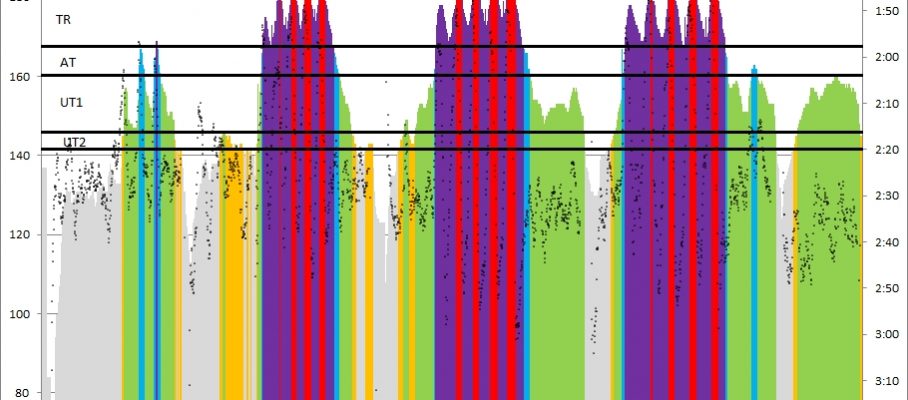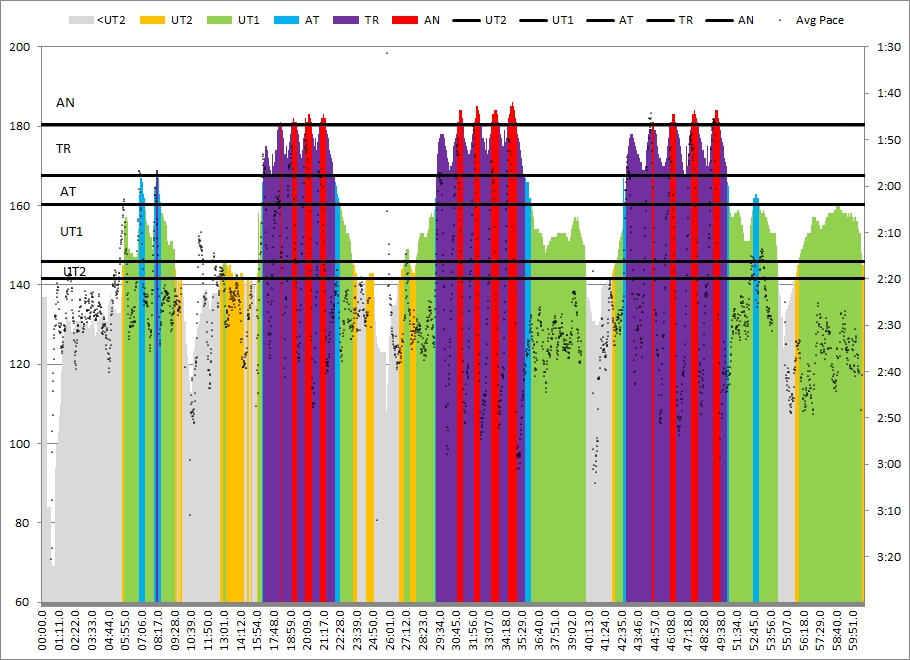Jun 30 2015
Monday: Another typical On The Water workout
There would be no point in doing this on the ergometer. This one is really about getting used to high stroke rates in real conditions (wind, waves, chop, traffic, buoys, and wake). Anybody can get up to 40spm on the erg, but getting good boat speed at 38spm in a single is more difficult.
This is another one from my personal list of interesting workouts that I collected over the years. It says:
3x(5×30″)/R8 (1) 30″/30″ @36spm, (2) 30″/45″ @ 38spm, (3) 30″/60″ @40spm
So three sets of 5 times 30 seconds of hard work, with mini rests that get longer for the higher stroke rates. Eight minutes rest between the sets. This is the first time I am doing it this season and I am not sure whether the stroke rates weren’t originally intended for the double or even the quad, so I lowered the target spm by 2.
The conditions: Alternating sun and a few drops of rain, light wind from the north (the nearby weather stations reported something else but in this hill country a weather station 5km away on the other side of the hill can report something entirely different), about 24 degrees C.
Warming up was uneventful. I did 3 10 stroke bursts at slightly higher stroke rate than my normal “warming up” bursts, and I took 3km of warming up instead of 2.
The first set was with slight tailwind, the second set with headwind and the final set with tailwind again. In the first interval of the second set, I had to suddenly steer in another direction because I was on a collision course with a tourist ferry. During the first set I thought I would not be able to survive the second and third sets, but the slightly longer rests combined by the fact that I really got used to the high rates were enough to save me.
Here are the data.
| Dist_ | Pace__ | _SPM | avg HR | max HR | DPS | Remarks
| 03161 | 02:38.6 | 20.1 | 136 | 169 | 09.4 | WU
| 00140 | 01:47.3 | 32.9 | 159 | 172 | 08.5 | 34spm #1 (32.0 / 1:46.2)
| 00136 | 01:50.1 | 33.3 | 174 | 180 | 08.2 | 34 spm #2 (33.9 / 1:48.1)
| 00133 | 01:52.7 | 32.8 | 176 | 182 | 08.1 | 34spm #3 (33.9 / 1:49.9)
| 00142 | 01:45.4 | 32.9 | 177 | 182 | 08.7 | 34spm #4 (34.0 / 1:42.2)
| 00139 | 01:48.2 | 33.0 | 176 | 182 | 08.4 | 34spm #5 (34.0 / 1:48.1)
| 01414 | 02:49.7 | 20.1 | 147 | 183 | 08.8 | rest 8min
| 00126 | 01:55.4 | 34.6 | 169 | 178 | 07.5 | 36spm #1 (34.0 / 1:54.7), steering
| 00137 | 01:49.5 | 34.8 | 176 | 181 | 07.9 | 36spm #2 (36.0 / 1:49.1)
| 00134 | 01:51.5 | 35.6 | 178 | 182 | 07.6 | 36spm #3 (36.0 / 1:48.7)
| 00143 | 01:48.1 | 34.3 | 177 | 183 | 08.1 | 36spm #4 (35.9 / 1:45.9)
| 00137 | 01:49.7 | 35.1 | 179 | 185 | 07.8 | 36spm #5 (33.9 / 1:48.7)
| 01425 | 02:48.4 | 19.6 | 152 | 186 | 09.1 | 8 min rest
| 00143 | 01:44.7 | 37.1 | 167 | 177 | 07.7 | 38spm #1 (38.0 / 1:43.0)
| 00145 | 01:46.7 | 36.4 | 174 | 179 | 07.7 | 38spm #2 (38.0 / 1:43.7)
| 00149 | 01:40.6 | 37.1 | 176 | 181 | 08.0 | 38spm #3 (37.9 / 1:39.1)
| 00140 | 01:47.0 | 36.6 | 176 | 183 | 07.7 | 38spm #4 ( (36.0 / 1:45.8)
| 00137 | 01:49.6 | 36.8 | 175 | 182 | 07.4 | 38spm #5 (37.9 / 1:45.7)
| 01916 | 02:59.3 | 20.1 | 155 | 184 | 08.3 | CD
I have removed the data for the mini rests as they are not interesting. In the comments I captured what CrewNerd reports me. In these short intervals it is slightly different from the excel spreadsheet. I guess it gives you a feel for the accuracy. The intervals were just 17 to 19 strokes long, and with one data point per second there are bound to be rounding errors.
Summary:
dist_____|time_____|_pace___|_HR__|_SPM__|_DPS|comment
3161_____|_16:43____|_2:38.6|136|20.1|9.4|warmup
2082_____|_07:31____|_1:48.3|174|34.9|8.0|Main set
1916_____|_11:27____|_2:59.3|155|20.1|8.3|Cool down
4553_____|_24:59____|_2:44.6|159|20.3|9.0|rest meters
11712____|_00:40____|_2:35.4|154|21.0|9.2|_Total
Happy with the paces achieved and even more happy with the stroke rates. During the 36spm and 38spm I really felt how I could work fast and still get reasonable stroke length.
This evening a session in the quad and I may have to do a 5km on the erg immediately after it to keep my promise to do each and every CTC of this year.


Dec 20 2016
The mysteries of the force curve
For OTW rowing, I am not even convinced a force curve should be looked at independently from boat speed and acceleration. On the other hand, wouldn’t it be great if we could extract a few meaningful parameters from the force curve to help analyze technique?
The approach Nielsen-Kellerman have taken is using “Slip” and “Wash” parameters, which basically tell give you a reduction in effective stroke length. Slip is basically the stroke length (or oar angle difference) it takes to get to 100N of force from the catch, and Wash is the oar angle difference (or stroke length) near the finish at which the force drops below 100N. The figure shows this well (from the brand new “stroke profile” plot on rowsandall.com).
It turns out that the schematic stroke profile is pretty close to the real one. When I calculate the area under the curve and compare with the average stroke force, there is pretty good consistency.
The ratio of average/peak force is a value between 0.5 and 1, the latter value just being a theoretical upper bound for a perfect block shaped force profile and the former the value for a triangular force profile. My values are pretty consistently around 0.57, but Greg Smith’s values are significantly higher (above 0.65 if I remember well).
So in the name of science, I did the following experiment on the erg. I must say using Painsled for iOS made it very easy to capture stroke profiles. I rowed a just row 150m off, 10 strokes “on”, varying stroke rate between 20 and 36spm. During the “on” strokes I tried to row what I consider good technique. Immediately after the 10th stroke, I grabbed the phone, did a screen capture, and took a picture of the PM5. I went up to 36spm, and back down, to see if there was consistency.
Before I show you all the raw data, here are the aggregate plots made on Rowsandall.com:
As you can see, my Average/Peak force ratio correlated positively with stroke rate, being 0.56 below 24spm, and 0.60 above 32spm. Drive length was pretty constant. I didn’t see a difference between going up the ladder or going down. Work per stroke correlated positively with the stroke rate, as did both average and peak force.
So here are the raw data, one set of stroke rates per picture gallery:
20 spm
24spm
28spm
32spm
36spm
The graphs from Painsled show the last stroke of the set of ten in bold, and a few of the strokes before in a lighter line. The pictures of the PM5 show the final stroke. I was struck by how different the pictures look from the graphs, but I guess that’s an effect of the vertical scaling.
I will have to think about this a bit more. Here is a link to the article by Kleshnev who has numbers between 0.5 and 0.6, with 85% of the rowers at the higher end.
I guess the next step will be to film my stroke.
At the least, I think this post is a good demonstration of the power of a good data analytics site, combined with the excellent erg data capture of Painsled.
Post Scriptum
Discussing the stroke profiles, Greg and I made the cumulative plots of the Average/Peak force ratio on rowsandall.com. Here are the two plots. Interesting to see the differences.
By sanderroosendaal • Uncategorized • 5 • Tags: concept2, erg, experiment, kleshnev, OTE, rowing, stroke rate, stroke ratio, technique